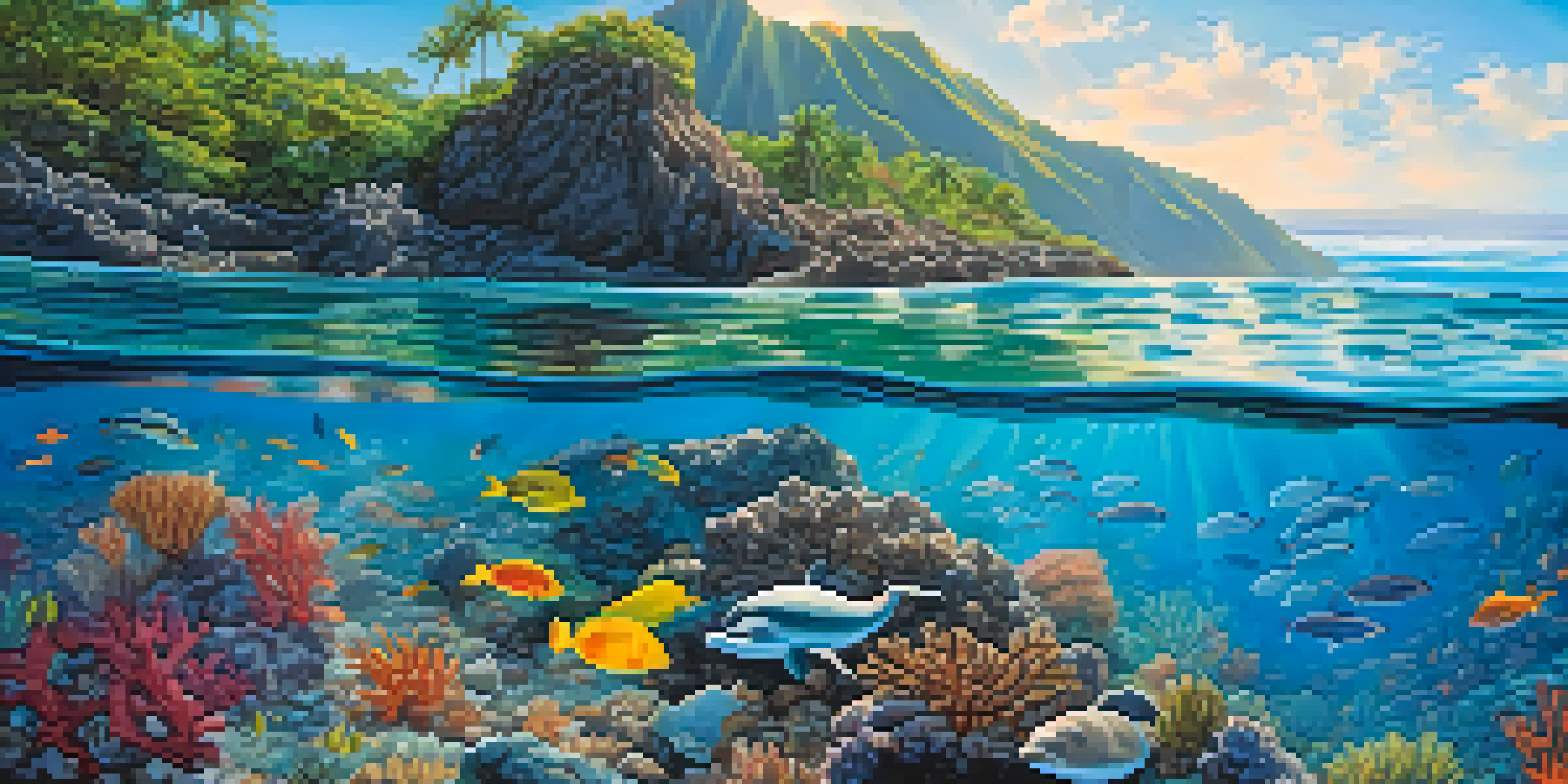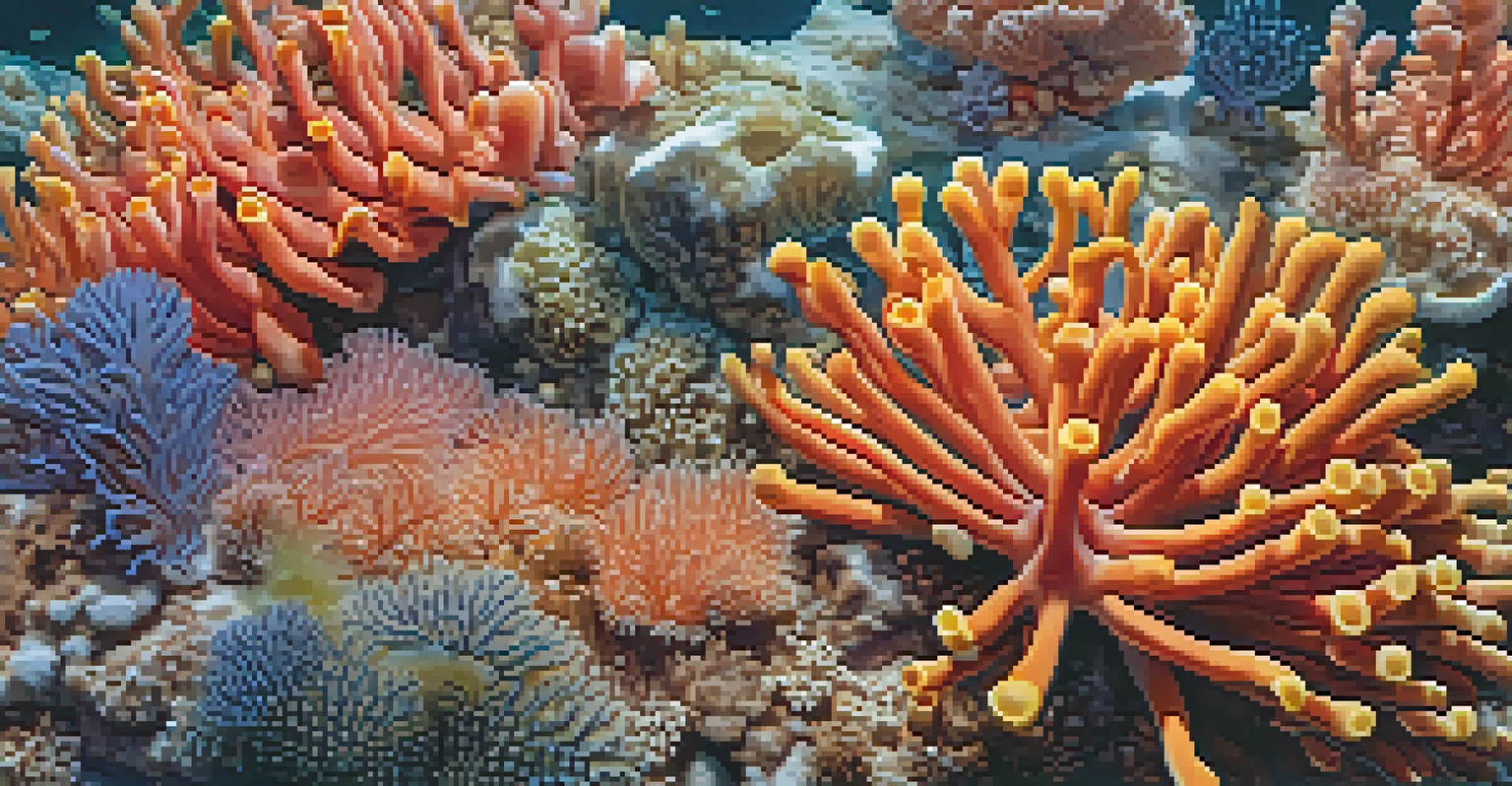Understanding Coral Reefs: Vital Ecosystems Around Honolulu

What Are Coral Reefs and Why Are They Important?
Coral reefs are vibrant underwater structures made primarily of coral polyps, tiny marine animals that cluster together. They provide critical habitats for a myriad of sea creatures, from colorful fish to larger marine mammals. Essentially, these ecosystems act as the ocean's equivalent of a rainforest, harboring diverse species and enhancing biodiversity.
Coral reefs are the most diverse ecosystems on the planet and are essential to the health of our oceans.
In addition to their ecological importance, coral reefs play a vital role in protecting coastlines from erosion and storm damage. They act as natural barriers, absorbing wave energy and reducing the impact of ocean storms on coastal communities. This protective function is particularly vital for areas like Honolulu, where the coastline is directly affected by ocean dynamics.
Furthermore, coral reefs contribute significantly to the local economy through tourism and fisheries. Snorkeling, diving, and other water activities attract visitors from around the globe, generating revenue and providing jobs. Thus, the health of coral reefs directly influences both environmental stability and economic prosperity.
The Unique Coral Reefs of Honolulu
Honolulu's coral reefs are unique, showcasing a blend of both hard and soft corals, which create a stunning underwater landscape. These reefs are home to various species, including the endemic Hawaiian monk seal and the vibrant parrotfish. Their presence adds to the colorful tapestry of marine life, making snorkeling and diving in the area an unforgettable experience.

One of the most notable areas is the Hanauma Bay Nature Preserve, famed for its rich biodiversity and crystal-clear waters. This protected marine area allows visitors to witness the beauty of coral reefs while promoting conservation efforts. It's a perfect example of how human interaction can coexist with nature when managed responsibly.
Coral Reefs: Essential Ecosystems
Coral reefs are crucial for biodiversity, providing habitats for numerous marine species and protecting coastlines from erosion.
However, these reefs face numerous threats, from climate change and coral bleaching to pollution and overfishing. Understanding the unique characteristics of Honolulu's reefs helps locals and visitors appreciate their value, emphasizing the need for ongoing conservation efforts to protect these delicate ecosystems.
Threats to Coral Reefs: A Growing Concern
Coral reefs globally are suffering from various threats that endanger their existence. Climate change is perhaps the most significant, with rising ocean temperatures causing coral bleaching. This phenomenon occurs when corals expel the algae that provide them with color and nutrients, often leading to widespread mortality.
The greatest threat to our planet is the belief that someone else will save it.
Pollution is another major threat, with runoff from land activities introducing harmful chemicals and sediments into the ocean. This pollution can smother coral and decrease water quality, making it difficult for these ecosystems to thrive. Additionally, plastic waste poses a danger, as it can entangle marine life and disrupt the natural balance.
Overfishing also impacts coral reefs by altering the balance of predator and prey species. When herbivorous fish are overfished, algae can grow unchecked, suffocating corals and diminishing their health. Addressing these threats requires collective action from governments, communities, and individuals to ensure the survival of these crucial ecosystems.
Coral Bleaching: Causes and Consequences
Coral bleaching is a distressing process where corals lose their vibrant colors and become white, often signaling stress due to environmental changes. The primary trigger for bleaching is elevated sea temperatures, which can occur during climate events like El Niño. When corals experience prolonged stress, they may eventually die, leading to the degradation of the entire reef ecosystem.
The consequences of coral bleaching are profound, affecting not only marine biodiversity but also the livelihoods of communities that depend on healthy reefs. As coral reefs decline, so does the abundance of fish and other marine life that rely on them for survival. This decline can have cascading effects on local fisheries and tourism, further exacerbating economic challenges.
Threats Endangering Coral Health
Climate change, pollution, and overfishing pose significant threats to coral reefs, leading to their decline and impacting local economies.
Efforts to mitigate coral bleaching include establishing marine protected areas and promoting sustainable fishing practices. Raising awareness about the causes of bleaching can empower individuals to make more environmentally friendly choices, such as reducing carbon footprints and supporting conservation initiatives.
Conservation Efforts: Protecting Our Coral Reefs
Conservation of coral reefs is crucial for maintaining their health and resilience. Various organizations and initiatives in Honolulu focus on protecting these ecosystems through research, education, and restoration projects. By engaging local communities and stakeholders, these efforts aim to foster a sense of stewardship for the reefs.
One effective strategy is the establishment of marine protected areas (MPAs), where fishing and other damaging activities are restricted. These zones allow coral reefs to recover and regenerate, providing safe havens for marine life. In Honolulu, initiatives like the Hanauma Bay Nature Preserve serve as successful examples of how MPAs can benefit both ecosystems and communities.
Additionally, public education plays a vital role in coral reef conservation. By informing residents and visitors about the importance of reefs and how to protect them, we can cultivate a culture of respect and care for these fragile ecosystems. Simple actions like reducing waste and participating in local clean-up events can make a significant difference.
The Role of Local Communities in Coral Reef Health
Local communities play a vital role in the health of coral reefs, as their actions can significantly impact these ecosystems. Engaging residents in conservation efforts fosters a sense of ownership and responsibility toward their marine environment. When communities come together to protect their reefs, they create a powerful force for positive change.
One way communities can contribute is by participating in citizen science programs, where locals help monitor coral health and track changes in marine biodiversity. These programs not only provide valuable data for researchers but also encourage participants to develop a deeper connection with the ocean. This engagement can spark a passion for marine conservation that extends beyond the individual.
Community Action for Coral Conservation
Local communities play a vital role in coral reef health through conservation efforts, sustainable tourism, and citizen science participation.
Moreover, supporting local businesses that prioritize sustainable practices can help promote reef-friendly tourism. When visitors choose eco-conscious tour operators or restaurants that minimize waste, they help reduce the overall impact on coral reefs. By fostering a culture of sustainability, local communities can ensure that coral reefs continue to thrive for generations to come.
What You Can Do to Help Coral Reefs
Everyone can play a role in protecting coral reefs, even from far away. Simple actions, like reducing plastic use and choosing sustainable seafood, can have a lasting impact. By being mindful of your choices, you contribute to the overall health of our oceans and coral ecosystems.
When visiting coral reef areas, be sure to follow guidelines set by conservation organizations. This includes avoiding touching or stepping on coral, as even the lightest contact can cause damage. Additionally, using reef-safe sunscreens can help protect these delicate ecosystems from harmful chemicals that may wash off into the water.

Finally, consider supporting organizations dedicated to coral reef conservation through donations or volunteering. Your involvement can help fund critical research and restoration projects, ensuring that coral reefs continue to thrive. Together, we can make a difference and ensure these vital ecosystems remain healthy for future generations.